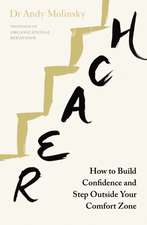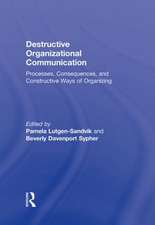Building Theories of Organization: The Constitutive Role of Communication: Routledge Communication Series
Editat de Linda L. Putnam, Anne M. Nicoteraen Limba Engleză Paperback – 18 dec 2008
The contents of this volume compare and contrast approaches to the notion that communication constitutes organization. Chapters also examine the ways that those processes produce patterns that endure over time and that constitute the organization as a whole. This collection bridges different disciplines and serves a vital role in developing dimensions, characteristics, and relationships among concepts that address how communication constitutes organization. It will appeal to scholars and researchers working in organizational communication, organizational studies, management, sociology, social collectives, and organizational psychology and behavior.
| Toate formatele și edițiile | Preț | Express |
|---|---|---|
| Paperback (1) | 484.47 lei 6-8 săpt. | |
| Taylor & Francis – 18 dec 2008 | 484.47 lei 6-8 săpt. | |
| Hardback (1) | 1114.30 lei 6-8 săpt. | |
| Taylor & Francis – 18 dec 2008 | 1114.30 lei 6-8 săpt. |
Din seria Routledge Communication Series
-
 Preț: 156.78 lei
Preț: 156.78 lei - 9%
 Preț: 575.54 lei
Preț: 575.54 lei -
 Preț: 155.43 lei
Preț: 155.43 lei - 8%
 Preț: 441.77 lei
Preț: 441.77 lei - 8%
 Preț: 417.13 lei
Preț: 417.13 lei - 9%
 Preț: 576.43 lei
Preț: 576.43 lei - 15%
 Preț: 404.22 lei
Preț: 404.22 lei - 8%
 Preț: 495.22 lei
Preț: 495.22 lei - 8%
 Preț: 509.90 lei
Preț: 509.90 lei -
 Preț: 392.96 lei
Preț: 392.96 lei - 8%
 Preț: 516.77 lei
Preț: 516.77 lei - 8%
 Preț: 460.12 lei
Preț: 460.12 lei - 8%
 Preț: 394.36 lei
Preț: 394.36 lei -
 Preț: 424.75 lei
Preț: 424.75 lei - 15%
 Preț: 431.10 lei
Preț: 431.10 lei -
 Preț: 364.94 lei
Preț: 364.94 lei -
 Preț: 363.96 lei
Preț: 363.96 lei - 22%
 Preț: 325.34 lei
Preț: 325.34 lei - 15%
 Preț: 463.49 lei
Preț: 463.49 lei - 15%
 Preț: 464.31 lei
Preț: 464.31 lei -
 Preț: 366.85 lei
Preț: 366.85 lei -
 Preț: 264.53 lei
Preț: 264.53 lei - 16%
 Preț: 247.75 lei
Preț: 247.75 lei -
 Preț: 354.28 lei
Preț: 354.28 lei -
 Preț: 374.27 lei
Preț: 374.27 lei - 22%
 Preț: 321.54 lei
Preț: 321.54 lei -
 Preț: 418.13 lei
Preț: 418.13 lei -
 Preț: 481.52 lei
Preț: 481.52 lei -
 Preț: 442.50 lei
Preț: 442.50 lei -
 Preț: 498.91 lei
Preț: 498.91 lei -
 Preț: 369.95 lei
Preț: 369.95 lei - 24%
 Preț: 133.28 lei
Preț: 133.28 lei - 31%
 Preț: 325.43 lei
Preț: 325.43 lei - 25%
 Preț: 769.37 lei
Preț: 769.37 lei -
 Preț: 447.05 lei
Preț: 447.05 lei - 18%
 Preț: 722.88 lei
Preț: 722.88 lei -
 Preț: 389.60 lei
Preț: 389.60 lei -
 Preț: 249.75 lei
Preț: 249.75 lei -
 Preț: 395.37 lei
Preț: 395.37 lei -
 Preț: 363.96 lei
Preț: 363.96 lei - 18%
 Preț: 1004.72 lei
Preț: 1004.72 lei - 18%
 Preț: 998.71 lei
Preț: 998.71 lei -
 Preț: 380.22 lei
Preț: 380.22 lei - 26%
 Preț: 243.26 lei
Preț: 243.26 lei -
 Preț: 97.53 lei
Preț: 97.53 lei -
 Preț: 242.11 lei
Preț: 242.11 lei - 20%
 Preț: 402.68 lei
Preț: 402.68 lei -
 Preț: 226.33 lei
Preț: 226.33 lei -
 Preț: 386.14 lei
Preț: 386.14 lei -
 Preț: 241.09 lei
Preț: 241.09 lei
Preț: 484.47 lei
Nou
Puncte Express: 727
Preț estimativ în valută:
92.70€ • 97.06$ • 76.89£
92.70€ • 97.06$ • 76.89£
Carte tipărită la comandă
Livrare economică 10-24 aprilie
Preluare comenzi: 021 569.72.76
Specificații
ISBN-13: 9780805847109
ISBN-10: 0805847103
Pagini: 240
Dimensiuni: 152 x 229 x 13 mm
Greutate: 0.34 kg
Ediția:New.
Editura: Taylor & Francis
Colecția Routledge
Seria Routledge Communication Series
Locul publicării:Oxford, United Kingdom
ISBN-10: 0805847103
Pagini: 240
Dimensiuni: 152 x 229 x 13 mm
Greutate: 0.34 kg
Ediția:New.
Editura: Taylor & Francis
Colecția Routledge
Seria Routledge Communication Series
Locul publicării:Oxford, United Kingdom
Notă biografică
LINDA L. PUTNAM (Ph.D., University of Minnesota, 1977) is a Professor in the Department of Communication at the University of California-Santa Barbara. Her current research interests include discourse analysis in organizations, negotiation, and organizational conflict. She is the co-editor of eight books, including Organizational Communication, The SAGE Handbook of Organizational Discourse, and The New Handbook of Organizational Communication.
ANNE MAYDAN NICOTERA (Ph.D., Ohio University, 1990) is an Associate Professor in the Department of Communication at George Mason University. Her research is grounded in a constitutive perspective and focuses on culture and conflict, diversity, race and gender, and aggressive communication, with a particular interest in healthcare organizations. She has also published four books and numerous articles on these topics.
ANNE MAYDAN NICOTERA (Ph.D., Ohio University, 1990) is an Associate Professor in the Department of Communication at George Mason University. Her research is grounded in a constitutive perspective and focuses on culture and conflict, diversity, race and gender, and aggressive communication, with a particular interest in healthcare organizations. She has also published four books and numerous articles on these topics.
Cuprins
Chapter 1 Introduction: Communication Constitutes Organization Linda L. Putnam, Anne M. Nicotera, and Robert D. McPhee Chapter 2 The Communicative Constitution of Organizations: A Framework for Explanation Robert D. McPhee and Pamela Zaug Chapter 3 Agents Of Constitution In Communicad: Constitutive Processes of Communication In Organizations Robert D. McPhee and Joel Iverson Chapter 4 Constitutive complexity: Military entrepreneurs and the synthetic character of communication flows Larry D. Browning, Ronald Walter Greene, S. B. Sitkin, Kathleen M. Sutcliffe, and David Obstfeld Chapter 5 Dislocation and Stabilization: How to Scale Up from Interactions to Organization François Cooren and Gail T. Fairhurst Chapter 6 Organizing from the bottom up?: Reflections on the constitution of organization in communication James R. Taylor Chapter 7 Theory Building: Comparisons of CCO Orientations Linda L. Putnam and Robert D. McPhee
Descriere
This volume explores the concept of communication as it applies to organizational theory, comparing and contrasting approaches to the notion that communication constitutes organization. Chapters also examine the ways that those processes produce patterns that endure over time and that constitute the organization as a whole. This collection bridges different disciplines and serves a vital role in developing dimensions, characteristics, and relationships among concepts that address how communication constitutes organization.















